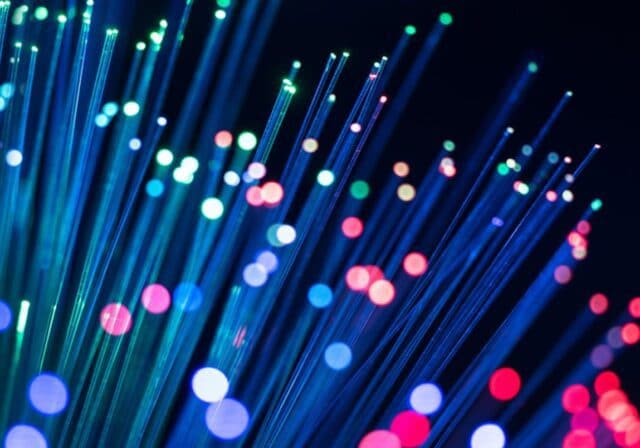Understanding fiber optics isn’t just for tech professionals anymore. If you're choosing an internet plan for your home or office, having a solid grasp of the basics can help you make smarter, faster decisions.
Let’s break down everything you need to know about fiber optic cables—from how they work, to the types available, to what kind of connection you should be looking for.
What are fiber optic cables?
In simple terms, fiber optic cables transmit data using pulses of light through strands of ultra-thin glass or plastic. These light signals carry your internet data—fast.
Fiber optic cables vs. traditional cables (like copper or coaxial)
Fiber optic cables come with a variety of benefits compared to other types of cables, including:
- Higher bandwidth: Fiber optics can handle massive amounts of data at lightning speed.
- Less interference: Unlike metal cables, fiber optics aren’t affected by electrical noise or weather conditions.
- Faster and more efficient: Their speed and efficiency play a big role in our increasingly connected world, especially for high-definition streaming, video conferencing, and smart homes.
2 types of fiber optic cables
Not all fiber optic cables are created equally. Here's a quick guide to the two main types of fiber optic cables out there, and how they’re used.
- Single-mode fiber (SMF)
- Thin core, designed for long-distance transmission.
- Common in large-scale networks like telecoms or data centers.
- Pros: High performance over long distances.
- Cons: More expensive, generally not used in average homes.
- Multi-mode fiber (MMF)
- Thicker core, used for shorter distances (e.g., in-office networks).
- Ideal for building-to-building connections and local area networks (LANs).
- Pros: Cheaper, easier to install.
- Cons: Not suited for long-range communication.
Fiber categories: Plastic vs. glass
Both of the cables discussed above can come in two different materials: plastic or glass. Let’s explore the qualities of plastic fiber vs. glass fiber optics cables.
- Plastic fiber
- Short-range, budget-conscious setups
- Fast setup, can be cut to length in the field
- Pros of plastic fiber optics cables: Cheaper, flexible, easier to install
- Cons of plastic fiber optics cables: Can’t withstand extreme environments/temperatures, or chemical/solvent exposure
- Glass fiber
- Commercial and industrial applications
- High speed data transmission over long distances
- Pros of glass fiber optics cables: Can withstand extreme temperatures, more bandwidth, less signal loss/interference
- Cons of glass fiber optics cables: More expensive, complex installation/maintenance, can break if bent too much
Here’s a handy breakdown of the more technical aspects to give you a better understanding.
Fiber optic cable types chart
| Cable Type | Core Size | Ideal Use | Benefits | Drawbacks |
|---|---|---|---|---|
| Single-Mode (SMF) | 8-10 microns | Long-distance, telecom, data centers | Fast, high capacity, long range | More costly, precise install |
| Multi-Mode (MMF) | 50-62.5 microns | Short-range, offices, LANs | Affordable, easier setup | Limited range |
| Plastic category | ~1mm core | Consumer devices, short runs | Flexible, low cost | Less durable, slower |
| Glass category | Micron-level | Most fiber internet networks | High performance, reliable | Higher cost |
4 fiber connection types
There are several fiber internet connection types, and the difference between them can impact your internet quality in a big way. Let’s explore 4 common fiber connection types: FTTH, FTTN, FTTC, and FTTB.
- FTTH (Fiber to the Home)
- Direct fiber line to your residence
- Best option for speed, reliability, and future-proofing
- FTTN (Fiber to the Node)
- Fiber runs to a nearby node, then uses traditional cables to reach your home.
- Slower than FTTH but often more widely available
- FTTC (Fiber to the Curb)
- Stops at a street-level pole or cabinet, then travels over copper wiring
- Better than FTTN, but not as fast as full FTTH
- FTTB (Fiber to the Building)
- Fiber reaches a shared location (like a condo or apartment), then splits off to individual units.
For top-tier performance, FTTH is the gold standard. It offers unmatched speed and reliability because there are no copper cables slowing things down.
How does fiber internet work?
Fiber internet works by converting electrical signals into light. These light pulses are transmitted through fiber optic cables, allowing for almost instant data delivery.
Key features:
- Equal (or nearly equal) upload and download speeds: Great for video calls, cloud backups, and remote work.
- Lower latency: Less lag = smoother gaming and streaming.
- Myth busting:
- No, fiber doesn’t break that easily—the glass fibers are covered by a jacketed cladding, making it a durable product that can be used in many environments.
- No, fiber internet installation isn’t a big issue for the average person—since professional installation is included with your service.
4 benefits of fiber internet for home
Why choose fiber over other home internet options? Let’s look at 4 real-world benefits of fiber optic connections.
- Speed and scalability
- Gigabit speeds today, scalable for your changing needs tomorrow
- Ideal for growing households and businesses
- Low latency & high reliability
- Fiber offers minimal lag and fewer slowdowns during peak usage times.
- Durable & weather resistant
- Immune to moisture, temperature shifts, and electromagnetic interference
- Built for smart homes & high-data use
- Perfect for households with multiple devices, security systems, and internet of things (IoT) tech.
Comparing fiber optic with other internet technologies
Wondering how fiber stacks up to other internet technologies, such as fixed wireless and DSL/cable? Here’s a quick look.
Fiber vs. Fixed wireless (5G home internet)
| Type | Fiber | Fixed wireless |
|---|---|---|
| Speed | Ultra-fast gigabit speeds | Fast 5G speeds |
| Reliability | Excellent | Good |
| Cost | Premium, best value | Affordable, great value |
| Availability | Expanding | Expanding |
| Installation | Wired setup | Easy, wireless setup |
Fiber vs. DSL/cable
Fiber beats DSL and cable on nearly every front: speed, consistency, and long-term viability. However, it’s not as readily available as DSL and cable yet.
A guide to choosing the right fiber plan
Not sure how to pick the right fiber plan? Here are 3 tips:
- Assess your needs: House full of streamers or gamers? Go gigabit. Light users? A lower-tier plan may be just fine.
- Understand your fiber connection type: FTTH is best, but FTTN or FTTC may still work well depending on your setup.
- Pick the right router: Look for features like Wi-Fi 6, dual-band support, and mesh compatibility to make the most of your fiber connection.
Whether you're browsing for a better plan, upgrading your home setup, or just curious about how the tech works, understanding fiber puts you in control.
T-Mobile Fiber offers gigabit speeds, no caps on data usage, a Wi-Fi mesh access point, and more. Plus, T-Mobile’s acquisition of the fiber-to-the-home provider, Lumos, means availability is quickly expanding. See if T-Mobile Fiber is available near you. Want to try a fast, reliable fixed wireless option? Try T-Mobile 5G Home Internet, America’s fastest growing home internet provider.
Learn More About Fiber Internet
- Internet Basics
- What is Broadband?
- DSL vs. Fiber vs. Cable vs. 5G Home Internet
- Upload vs. Download Speed: What You Need To Know
Sources:
https://www.fcc.gov/consumers/guides/getting-broadband-qa
https://www.gartner.com/en/information-technology/glossary/fiber-optics
https://www.gartner.com/en/glossary
https://www.zdnet.com/home-and-office/networking/fiber-vs-cable-what-is-the-difference
https://tripplite.eaton.com/products/fiber-optic-cable-buying-guide
https://www.lumitex.com/blog/optical-fiber-technology
https://www.c1c.net/blog/the-pros-cons-and-difference-between-cable-and-fiber-optic-internet/
https://t-mobilefiber.com/fiber-internet-service/benefits-of-fiber-internet-speed-and-wifi-6
https://www.techtarget.com/searchnetworking/definition/fiber-to-the-home
https://www.cnet.com/home/internet/fiber-internet-explained
https://mariushosting.com/difference-between-fttn-fttc-fttb-and-ftth
https://broadbandnow.com/guides/dsl-vs-cable-vs-fiber
https://www.inneos.com/busting-myths-about-fiber-optic-cables/



